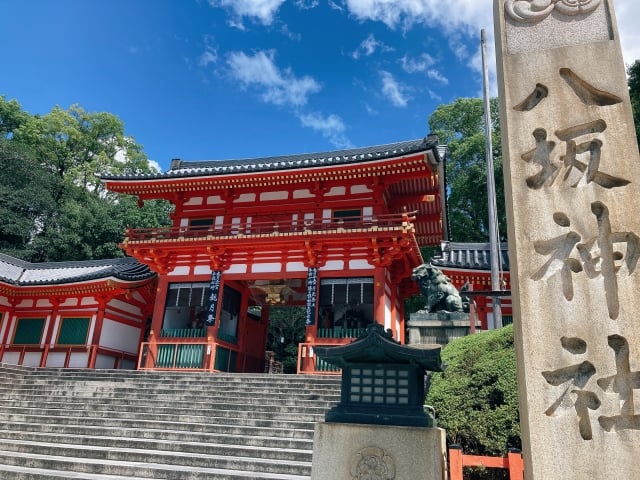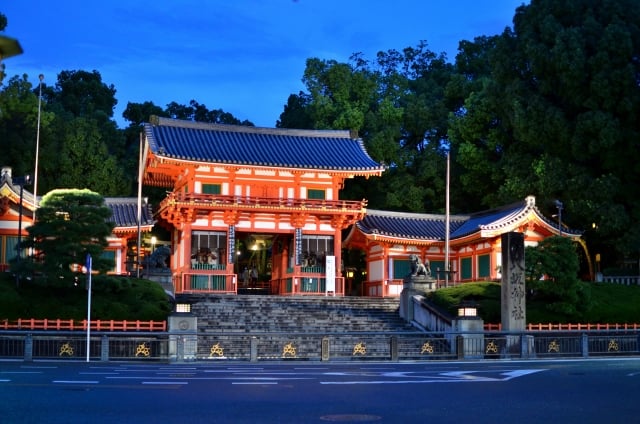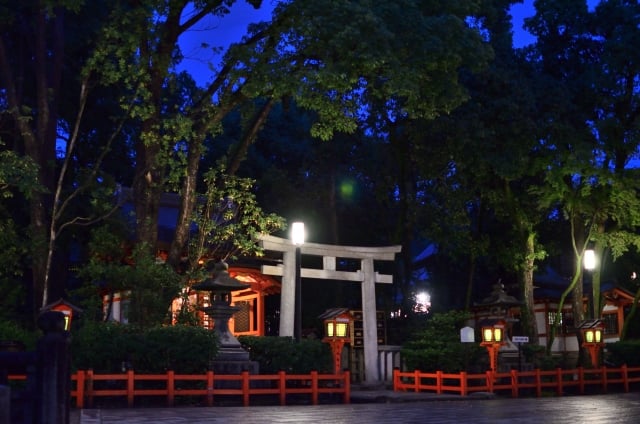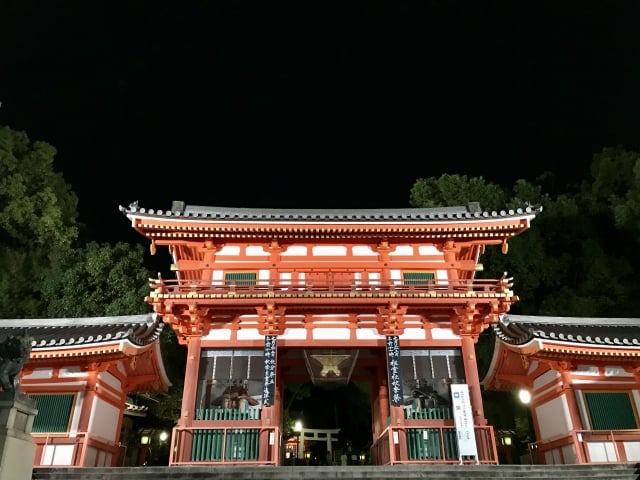Yasaka Shrine is located in the Gion area, Kyoto's most famous red light district, where the traditional scenery still remains.
It is a gorgeous shrine with a conspicuous vermilion gate, and is one of the most popular shrines among tourists.
Yasaka Shrine can be visited not only during the daytime but also at night.
At night, the Nishiro-mon gate along Shijo-dori is lit up and a row of lanterns in the Buden (dance hall) across from the main shrine is lit up, creating a fantastic and beautiful atmosphere.
In this article, I, a Kyoto resident, will tell you about visiting Yasaka Shrine at night.
About Yasaka Shrine

The history of Yasaka Shrine dates back to 876, when Ennyo, a priest from the southern capital, built a hall at the foot of Higashiyama
Many of Yasaka Shrine's buildings are valuable. The main hall is designated as a National Treasure, and 29 other shrines, sub-shrines, and buildings are designated as Important Cultural Properties.
The vast grounds bordering Maruyama Park, which is famous for its cherry trees, and Shijo Street, which leads to Gion, is also a good place to take a walk.
Yasaka Shrine is also famous for the Gion Festival, one of the three major festivals in Japan, which attracts many tourists every year during the month of July starting on July 1.
The town of Gion itself is a great place to visit, especially for foreign tourists, as it offers a view of the good old traditions of Japan.
The charm of Yasaka Shrine at night
Yasaka Shrine attracts many visitors during the daytime, but since it is open 24 hours a day, a visit at night is also recommended.

At night, the Nishiro-mon Gate along Shijo-dori is illuminated, and its vermilion color stands out even more, giving visitors a sense of the beauty of traditional Japanese architecture.
Walking along the approach to the shrine, you can enjoy the fantastic atmosphere of the lanterns that illuminate the Buden (dance hall) across from the main shrine building in the darkness.

The lanterns are dedicated by teahouses and ryotei restaurants in the Gion area, and this scene has a reputation for being very Japanese and beautiful.

The Minamiroumon (south gate) in front of the Buden (dance hall) is not as spectacular as the Nishiroumon (west gate) introduced at the beginning of this page, but this is actually the main gate.
It is a good idea to visit the shrine from the Minami-Roumon gate.
Don't miss the "Mitama-utsushi" during the Gion Festival in July!

The “Mitama-utsushi” during the Gion Festival, held every July, is the best way to enjoy the night at Yasaka Shrine.
Every year on July 17 and 24, three portable shrines begin to return to the shrine at around 10:30 p.m., and at around midnight, the “Mitama-utsushi (relocation of the divine spirits)” is held to return the spirits carried on the portable shrines to the main shrine building.
With all the lights in the precincts of the shrine turned off at once and the sound of the koto (Japanese harp) echoing in the background, the ritual of returning the divine spirits, hidden by a white cloth so that visitors cannot see them, back to the main shrine is performed.
The priests' voices echo, “Oh, oh, oh,” followed by a moment of silence in the darkness. After that, the lights are turned on and the ceremony ends.
The contrast between the light and darkness, the shouts and the silence, is strikingly sacred, and one can feel the depth of Japanese culture.
If you are visiting Kyoto at this time of the year, you should definitely come and visit.
A foreign tourist's disturbing behavior at Yasaka Shrine at night has caused a firestorm on social media in the past

Yasaka Shrine is open to visitors at night, which is appreciated by people working in Gion and those visiting Kyoto on business from afar, but in the past, there was an incident that flared up on social media due to the bad manners of foreign tourists visiting the shrine at night.
In Japan, it is customary to “ring the bell,” which is a hemp rope hanging in front of the shrine, when visiting the shrine.
This is because the purifying sound of the bell is believed to both prepare the worshipper's mind and ward off evil spirits.
Therefore, Japanese people do not shake the bell violently, but rather shake it a few times to make a sound, and then go to the shrine to make themselves feel better.
But one night, one of the foreign tourists was enjoying the “bell cord” as if it were an attraction, handling it roughly as if he were smashing it.
When a Japanese woman living in Kyoto saw this and asked the foreigner to treat it with care, the foreign man guiding the foreigner spat out a rude remark at the Japanese woman, and the video was spread on social media, causing a huge firestorm.
The foreign man who was guiding the foreigner was criticized.
In response to these inflammatory incidents, Yasaka Shrine now announces that the bell cord will be fixed at 5:00 p.m. in a position out of the reach of worshippers, and the bell cannot be rung at Yasaka Shrine today, although visitors can still visit the shrine at night.
<Quotes from the Yasaka Shrine official website>
For the safety of all worshippers, the bell cord in the main shrine will be raised from around 5:00 pm to 6:00 am the following day.
During this period, you may visit the shrine normally, but you may not ring the bell. (Source:Yasaka Shrine)
Until now, visitors to Yasaka Shrine, which has a history of more than 1,200 years, were allowed to ring the bell to pray even at night.
To ensure that Kyoto's continuing historical culture is not lost, when visiting the shrine, please be careful not to abuse the shrine's facilities or disturb other worshippers by being loud and boisterous.
Yasaka Shrine is also recommended to visit at night!
Yasaka Shrine is popular during the daytime, but visiting at night is also recommended, as you can enjoy a different atmosphere at night than in the daytime.
After finishing dinner at Shijo or Gion, why not take a night stroll and visit the shrine?
Yasaka Shrine
Address: North side of Gion-cho, Higashiyama-ku, Kyoto-shi, Kyoto
Phone:075-561-6155(9 am-5 pm)
Prayer services available 24 hours a day
Access: 5 minutes walk from "Gion-Shijo" station of Keihan Railway / 8 minutes walk from "Kyoto Kawaramachi" station of Hankyu Railway / A short walk from "Gion" bus stop of city bus No. 100 or 206 from JR Kyoto station
